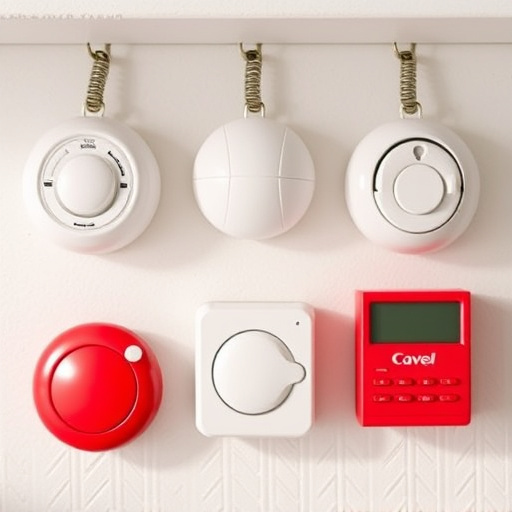Discrete wearable security alarms, worn as necklaces or bracelets, offer powerful personal protection with loud sirens. Their advanced batteries provide reliable, extended usage for outdoor activities and daily commutes. However, continuous siren activation, display features, and environmental factors drain the battery, requiring frequent replacements or recharging. To maximize Personal Safety Siren Battery Life, users should clean devices regularly, calibrate accurately, use low-power modes, set triggers judiciously, leverage motion sensors/app notifications, schedule power-downs, and keep firmware updated.
In today’s world, personal safety is paramount, and discrete wearable security alarm systems offer a compelling solution. This article delves into the intricacies of these innovative devices, focusing on their key components, battery life considerations, and best practices for maintenance. Understanding how these systems function and optimizing their performance, especially regarding Personal Safety Siren Battery Life, can enhance individual security and peace of mind in various settings.
- Understanding Discrete Wearable Security Alarm Systems
- Key Components of a Personal Safety Siren System
- Factors Affecting Battery Life in Wearable Alarms
- Best Practices for Maintaining and Extending Battery Life
Understanding Discrete Wearable Security Alarm Systems
Discrete wearable security alarm systems are a revolutionary way to ensure personal safety, offering a compact and discreet solution for individuals seeking peace of mind. These innovative devices are designed to be worn as accessories, such as necklaces, bracelets, or even pins, allowing users to carry a powerful tool for self-defense in their everyday lives. The core feature is a built-in siren that can emit loud, attention-grabbing sounds when activated, deterring potential threats and drawing help.
With advanced technology, these wearables boast impressive battery life, ensuring they remain operational when needed most. Users can rely on them for extended periods without frequent recharging, making them convenient and reliable companions for outdoor activities, travel, or daily commutes. This portability and longevity make discrete wearable security alarm systems an attractive option for anyone prioritizing personal safety in their daily routines.
Key Components of a Personal Safety Siren System
Personal safety siren systems are designed to provide individuals with a discrete yet powerful tool for protection. Key components include a compact and lightweight siren device, typically worn as a necklace or bracelet, and an alarm trigger that can be easily activated in case of danger. These wearables often boast advanced features such as long-lasting battery life, ensuring users remain protected throughout their day without constant recharging concerns.
The battery life of these personal safety sirens is a critical factor, optimized to offer extended usage between charges. This allows users to rely on the device when needed most, be it during evening walks or late-night commutes. Advanced technologies like energy-efficient circuitry and smart power management ensure the siren remains operational, providing peace of mind and an extra layer of security for its wearer.
Factors Affecting Battery Life in Wearable Alarms
The battery life of wearable security alarm systems, often featuring a personal safety siren, is influenced by several key factors. Firstly, the frequency and duration of siren activation significantly drains the battery. Continuous or frequent use can lead to quicker depletion, requiring more frequent replacements or recharging. Secondly, the overall power consumption of the device plays a crucial role; advanced features, higher display brightness, and complex connectivity options may draw more energy, thereby reducing battery longevity.
Additionally, environmental conditions can impact performance. Extreme temperatures, whether hot or cold, can affect battery chemistry, potentially leading to faster discharge. Moisture exposure is another factor; water-resistant designs help but excessive humidity might still cause issues. Lastly, the initial charge and age of the battery also contribute to its overall lifespan, with proper care and regular maintenance extending the useful life of these portable safety devices.
Best Practices for Maintaining and Extending Battery Life
To maximize the Personal Safety Siren‘s battery life, users should adopt several best practices. Regularly clean the device to remove any dust or debris that could hinder airflow and impact performance. Additionally, ensuring the sensor is properly calibrated helps optimize power usage by avoiding false triggers. Users should also take advantage of low-power modes when the device is not actively being used.
Extending battery life involves strategic use patterns. This includes setting the siren to active only when necessary, utilizing motion sensors or app notifications to trigger alerts, and scheduling automatic power-down periods during times of inactivity. Regularly updating the device’s firmware can also improve efficiency and longevity, so staying current with updates is essential for maintaining optimal Personal Safety Siren battery life.
Discrete wearable security alarm systems, with their compact yet potent personal safety siren capabilities, offer enhanced peace of mind in today’s digital era. By understanding key components and factors affecting battery life, users can maximize the effectiveness and longevity of these devices. Best practices for maintenance and extension of battery life ensure these wearables remain reliable companions, providing crucial protection when needed most.
